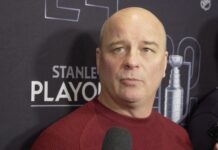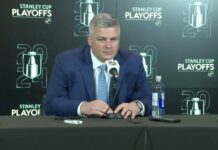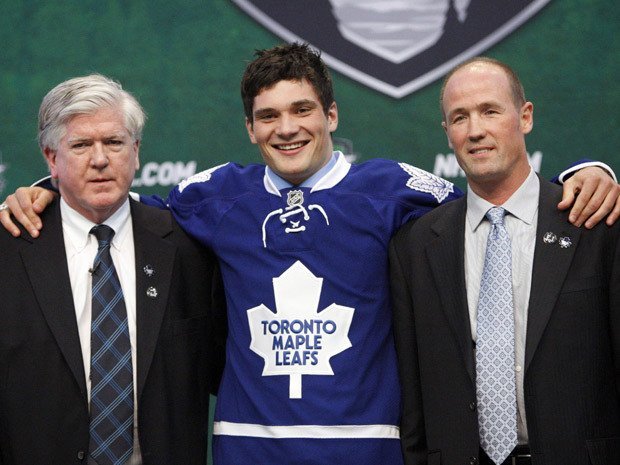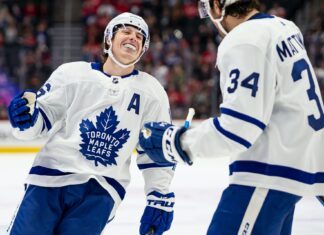As mentioned earlier, I had the privilege of chatting with Maple Leafs‘ Director of Amateur Scouting, Dave Morrison this morning to glean some his insight for an upcoming piece in this year’s edition of the Maple Leafs Annual. For that content, you’ll just have to wait until September. However, I was given the go-ahead to pass along for your enjoyment some of the content that will not be used in the Annual. Bear in mind, the flow of the interview may appear a little off as these are excerpts pulled from various sections.
James Reimer really burst onto the NHL scene with a fantastic stretch of games as a rookie, but seemed to struggle a little bit toward the end there. Is conditioning one of those things James needs to work on in order to solidify himself as a true number one goaltender?
Morrison — You—re right Alex, this was his first real extended stretch of games at the NHL level and that was a big challenge. He certainly proved himself at the AHL level, but the workload he shouldered there at the end¦ any goalie would start to feel the effects of that. That part of James— game and the process of him learning how to be THE guy are going to come with experience and maturity. He understands what he needs to do. The management staff as well¦ they—re going to work with James as well to know when he—s okay to play and when he may need a night off here and there.
After James Reimer was promoted to the big club, it was Ben Scrivens— turn to steal the show as a rookie goaltender with the Marlies, putting up some very impressive numbers. Should Jonas and James be looking over their shoulders a little bit at the NHL level?
Morrison — Haha, well any goalie should be always looking over their shoulders. The skaters should be too. There should always be an element of competition there at all times because it forces everyone to stay honest and continue to want to improve. We know Scrivens is a very good young goaltender and that he—s chomping at the bit to see some NHL action. At some point, he will push for an NHL job and that could be as early as sometime next year, but I certainly expect James and Jonas to be prepared for that possibility and to work their butts off to keep their jobs. We—re in a great situation with a bevy of good young goalies moving forward.
Jesse Blacker seemed to have quite the breakout offensive season in the OHL this year thanks to increased ice-time and responsibility. How does he compare to Stuart Percy and Jake Gardiner in terms of puckmoving ability and offensive upside?
Morrison — Oh boy, that—s a tough question. Well Jesse—s definitely a good one. All three of those guys are excellent puckmoving defensemen but each of them approaches the game with a bit of a different feel. Stuart—s not as flashy as Jesse or Jake but his intelligence more than makes up for it as he possesses an excellent understanding of the game. That—s not to take anything away from the other two, but Stuart just seems to incorporate it more into his game. Jesse and Jake on the other hand, are a little stronger on their feet in terms of agility and rushing ability. I suppose in the end, one of them will end up being the best of the group, but it—s doesn—t matter who. We—re in a great situation to have three high upside defensemen who should all be able to contribute at the next level.
You traded up for your top selection of this year—s draft, snagging power forward Tyler Biggs, a ferocious checker, with the 22nd pick of the first round. What were some of the skills you saw that really drew you to him? Word is you guys actually had Percy rated a little higher than Biggs, but you called a draft floor audible to make sure you got both. Tell us about that.
Morrison — Like you said, Tyler is a big, strong guy with a great physical element to his game. He—s got the upside of a power forward because he can play with a hard hitting, nasty edge but he—s also got the offensive skills to complement a scoring line. We love that he goes out there and gets his nose dirty in the corners. These types of players are very hard to find because teams just don—t let them go.
We were sitting there at the draft table with picks 25 and 29 coming up and we knew there was no way we were going to get both where we were. So after trading up for the 22nd pick, I just had a feeling that Biggs was going to go before Percy within the next few picks. This is just one of those instincts you develop after years of experience and being on the floor for several drafts. It was something I discussed with my colleagues, who also shared the feeling. So we went ahead with our selection and just crossed our fingers, hoping that Percy would make it to 25. We really had no idea if it was all going to work out but we—re very thankful that it did.
Let—s switch gears a little bit and finish off with some draft related questions. There was talk this year of teams putting a lot more time and effort into the interview process, even meeting with players that were significantly out of their projected range. Was this simply a matter of the 2011 draft class being one where there was little difference between say picks 20 through 50, thus prompting the need to be prepared for any scenario?
Morrison — Absolutely Alex. That—s one part of it. You always want to be prepared for anything, whether that—s a player being unexpectedly available or trade options presenting themselves. The other aspect of it may simply just be the evolution of scouting as teams realize the importance of drafting well in the cap era. More time and money is being invested into the process and the teams that do so will reap the benefits later on down the road.
With the recent regime change in the management team of the city—s baseball team (Blue Jays), current General Manager Alex Anthopoulos talked about a new approach to drafting where the organization sought out players with a 10% chance at developing into a star preferentially over players with a 50% chance of developing into an average player. What are your thoughts on such a drafting philosophy? Is it realistic to draft that way in hockey?
Morrison — That—s an interesting question. My team and I are always trying to find that diamond in the rough¦ a true difference maker as it were. But like with baseball, it—s important to keep in mind that there are different ways for a player to positively impact a team. Some organizations have gotten especially good at identifying those riskier, high upside guys. Over the years, our team has been targeting increasingly higher risk-reward type players, much more so than four or five years ago. It becomes a lot easier to do so when you manage to acquire depth through free agent signings like Tyler Bozak, Ben Scrivens and Jussi Rynnas. That frees you up to get a little more adventurous on the draft floor.
Let—s say you—ve selected a couple of higher risk players in the early rounds. Do you seek to contrast those selections with some safer guarantees with defined roles in the later rounds? I would imagine it—s quite important to ensure you leave the draft floor with at least a few NHL contributors?
Morrison —Maybe in the past we would do a little more of that. Now, we feel pretty confident taking high risk players because of all the homework we do to learn about a player, from a personal, medical and physical standpoint. A certain player may be further away from becoming an impact player but if we see that they have the right mentality and character to put in the work to get there, that makes us feel a lot better about a particular selection. Extensive homework is what gives us a better chance with these high upside risks.
When scouting a player, on average, how many games do you feel are required in order to make a proper assessment of that player—s abilities?
Morrison — You see Alex, it honestly depends on the game. Sometimes it—s one game¦ sometimes it—s two games¦ sometimes it—s six games. I read and receive a ton of reports everyday from all of our scouts and those are extremely important. If I were to go see a player, there could be any number of factors in play that could skew what I—m seeing. It could be a Sunday afternoon game for example where that player is tired after three games in two and half days, so perhaps I would consider coming back and watching him play on a Friday night.
One last question.There seems to be considerable hype building for the upcoming 2012 draft class. What—s your early impression of that next crop of young players? Could it be realistically likened to the 2003 class where you see several all-star calibre players like Getzlaf, Perry, and Parise being selected in the late first round, or is that a little on the optimistic side?
Morrison — That—s probably a little optimistic. I will say that the next group of players certainly looks very good and that throughout the course of this past year, the reviews on some of these underage players have been jumping off the page. However with any young player, a lot can change over the course of a year, so I like to stick with a wait and see approach before passing any final judgment.
Well, that’s it from me. A big thank you from both MLHS and the Maple Leafs Annual for letting us interrupt you during your much deserved time off.
Morrison — My pleasure Alex. Anytime.


![Sheldon Keefe on the Maple Leafs’ struggling power play: “[We’ve scored] one out of 11 high-danger chances in tight to the net… We have been in those spots and haven’t converted” Sheldon Keefe, playoff press conference](https://mapleleafshotstove.com/wp-content/uploads/2024/04/keefe-pc-game-3-218x150.jpg)

![Jim Montgomery Post Game, Bruins 4 vs. Leafs 2: “[Marchand] still manages to get under people’s skin, yet he doesn’t cross the line” Jim Montgomery, Boston Bruins post game](https://mapleleafshotstove.com/wp-content/uploads/2024/04/jim-monty-pg-to-218x150.jpg)























![Sheldon Keefe on the Maple Leafs’ struggling power play: “[We’ve scored] one out of 11 high-danger chances in tight to the net… We have been in those spots and haven’t converted” Sheldon Keefe, playoff press conference](https://mapleleafshotstove.com/wp-content/uploads/2024/04/keefe-pc-game-3-100x70.jpg)



![Jim Montgomery Post Game, Bruins 4 vs. Leafs 2: “[Marchand] still manages to get under people’s skin, yet he doesn’t cross the line” Jim Montgomery, Boston Bruins post game](https://mapleleafshotstove.com/wp-content/uploads/2024/04/jim-monty-pg-to-100x70.jpg)

